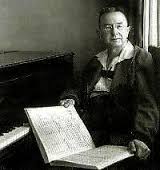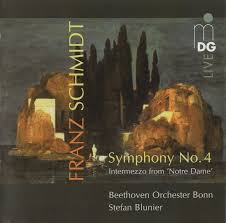A revised version of this appeared at Violinist.com in 2008
As the story has it, when Hungarian-born 20th century composer Franz Schmidt received the news in 1932 that his beloved daughter and only child, Emma, had died in childbirth, it was just prior to his setting to work on his Symphony no. 4 in C Major. The loss affected him profoundly, resulting in a breakdown, both spiritual and physical, from which he was able to pull himself up to deliver a gorgeous, evocative, fully realized masterpiece. Completing this symphony in 1933, Schmidt inscribed it as “a requiem for my daughter.”
Schmidt’s Symphony no. 4 in C Major was part of an October 2008 San Francisco Symphony performance I attended. Joshua Bell was the night’s headliner, with Saint-Saens’ Introduction and Rondo Capriccioso and Ravel’s Tzigane. Normally when the “star” performs in the first half, there is a sense, following intermission, that the best of the concert has passed, particularly when the next piece is by a little-known composer, a little-known 20th century piece of music. This was not the case on Saturday night, however. Far from it.
I didn’t know I needed sad music. I read the program notes on Schmidt’s Symphony no. 4 during intermission, curiosity stirring the heavy feeling I’d been carrying around all day. I tend to avoid sad movies and books when in this kind of mood. I get too sucked into their sadness and can’t shuck the weight of it afterwards. But bittersweet music often steps right in and connects with whatever sense of loss I myself am experiencing. My lament on Saturday was minor: I was emotionally out of sorts from having just finished the second draft of my novel the day before, putting me one step closer to completing the project. It is never the triumph for me one might think it would be. Granted, there’s a headiness as you cross the finish line, but the next day, upon rising, it’s a sense of emptiness that greets you. Never mind that your brain is fried and you couldn’t have worked on it much longer anyway. Never mind that you’re not done, done. That weeks, possibly months of editing to fit the specifications of an agent are involved. But analysis and explanation did not ease my gloom that night.
There’s something so gorgeous, so soothing, so lush and expansive about Schmidt’s 4th Symphony, from the very first notes. It feels like grief, but the good part of it, that temporary high, that larger-than-life clarity that presents itself amid the process. It did not tear me up inside, the way the Sibelius violin concerto will do. It is more like Mahler, or Bruckner. The rhythmic and harmonic complexity, the shattering reverberating sound of the gong, the crashing cymbals, remind the listener that this is 20th century music. This is not insipid, easy-listening orchestration. It is grief. It is a lament. It is full of highs and lows, moments of ecstatic soulfulness preceding and following desperate conflict.
The symphony begins and ends with a long melody on unaccompanied solo trumpet, a herald. Solos from other parts of the orchestra—notably the cello—pepper the symphony’s four movements, lending it the richness and thrill a violin concerto always brings me. The second movement, the Adagio, is simply exquisite, particularly with the contribution of the aforementioned cello solos (Schmidt was an acclaimed cellist, performing and soloing with the Vienna Philharmonic for fifteen years). In the San Francisco Symphony program notes, author Michael Steinberg wonderfully describes when the mood during the adagio darkens. “Against a drumming whose relentless beat begins in the timpani but comes to take over the whole orchestra, the cellos begin a mournful threnody—music of searing grief, a funeral march that can stand beside the greatest by Beethoven, Berlioz, Wagner, Mahler, Elgar and Shostakovich. Its mountainous climax is the focal point of the entire symphony.” Give it a listen. (If the embed didn’t work, click here…https://www.youtube.com/watch?v=uRvTthQ3vmU)
http://
This mood. This elegy. It is so perfect. It makes grief beautiful. It elevates it to something irreproachable, like snow on a mountain peak that, when you’re stumbling around in it, stings and chills and makes you lose your footing, but from the distance, oh, the inexpressible beauty. From this perspective, it not only makes sense, but it seems a necessary sacrifice.
Schmidt’s lament. Small consolation for him and his loss at the time, but how lucky we are, how enriched, to have this work of art that so aptly displays the curious symbiosis between pain and beauty, loss and eternal gain—the ineffable power of the wordless requiem. Such a treasure to discover on a Saturday night in Davies Hall, well after the “headliner” has stepped off the stage.
Five and a half years later, in 2014, I’m still remembering this symphony from a little-known (in the U.S.) composer, his art, his loss, this tribute to his daughter. Through it, they can both live on eternally. Bravo, maestro.



Thanks for another inspiring essay. Never heard of the guy before.
Grace
Grace – isn’t it fun, coming upon a brand new name from the past and then loving the music? That was the case, for me, with Gliere, as well. (Ever hear of HIM?) His Symphony no. 1 is absolutely delicious.
I really enjoyed reading this. I’m in the toddler stages of admiring classical music and it’s really intoxicating to hear something for beautiful for the first time.
Lisa, I love your line about “…toddler stages of admiring classical music” – what a great image! Oh, wow, I’m so with you about the intoxication of hearing something beautiful for the first time. One good thing to know about the classical music game is that you can listen to something a few times and not fall in love with it immediately. Then, one day, BAM. (That was the case for me with the St. Saens Violin Concerto no. 3, the second movement.) And now I’m stumbling all over myself thinking of The Best Stuff to suggest to you to try. Gosh, maybe I’ll make that its own blog. In the meantime, I’d highly recommend Dvorak, his “Romance in F-minor,” his string quartet no. 12, “The American”. Anything by Chopin. In fact, check out my blog on “Chopin for Everyone” (http://www.theclassicalgirl.com/chopin-everyone/). It has two embedded playlists, each over an hour long. Also, anything by Bruch, although he is best known for his violin concertos. The Brahms Violin Concerto. Schumann’s “Rhenish” Symphony, no. 3, is very enjoyable.
Oh… so much music to recommend, so little time! Yes, this is definitely a good thing to create a blog about – thanks for the inspiration, Lisa!
PS: Next morning I’m remembering this relatively new infatuation of mine, Tchaikovsky’s Symphony no 1. Just love this! (Listening to it as we speak.) Here’s another embedded link, plus the story behind creating it — a charming, feisty story, to boot. http://www.theclassicalgirl.com/creating-the-first/
How much more enriched we would be if this great work were better known than it is. There must have been countless music lovers who have been deprived of an opportunity to hear and know it by the cultural politics of the immediately postwar era, which rendered Schmidt a musical non-person, in spite of his extraordinary genius.
Neil, I love what you wrote, and I’m in complete agreement. I guess the best we can do is precisely what we’re doing: sharing thoughts about his work online, sharing links, getting the word out that this is one damned fine composer who deserves to be better known.
Thanks so much for leaving your comment!
Have you happened upon his Variations on a Hussar Song? Some exquisite shading from the murky pre-theme to the fleet-footed final variations and denouement.
Michael, I’ve heard no other music of his, and I’m delighted to get a suggestion. Thank you, thank you! Will definitely check that piece out. Thanks for taking the time to reply here!